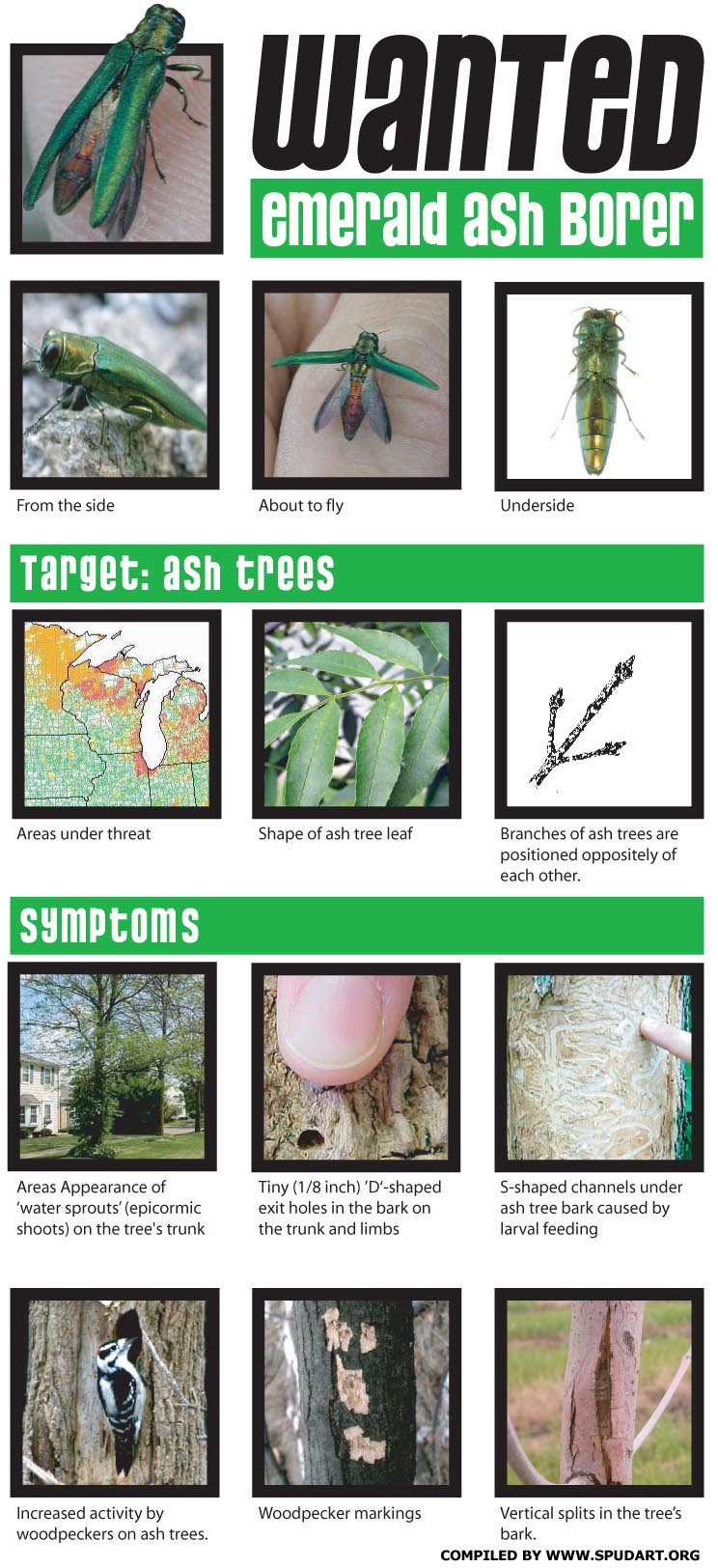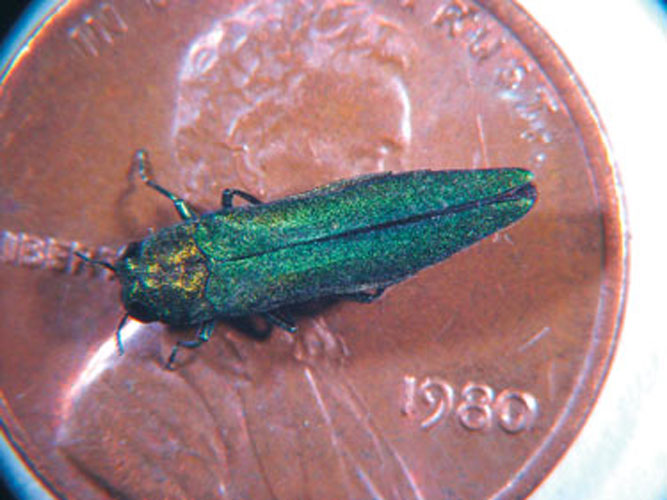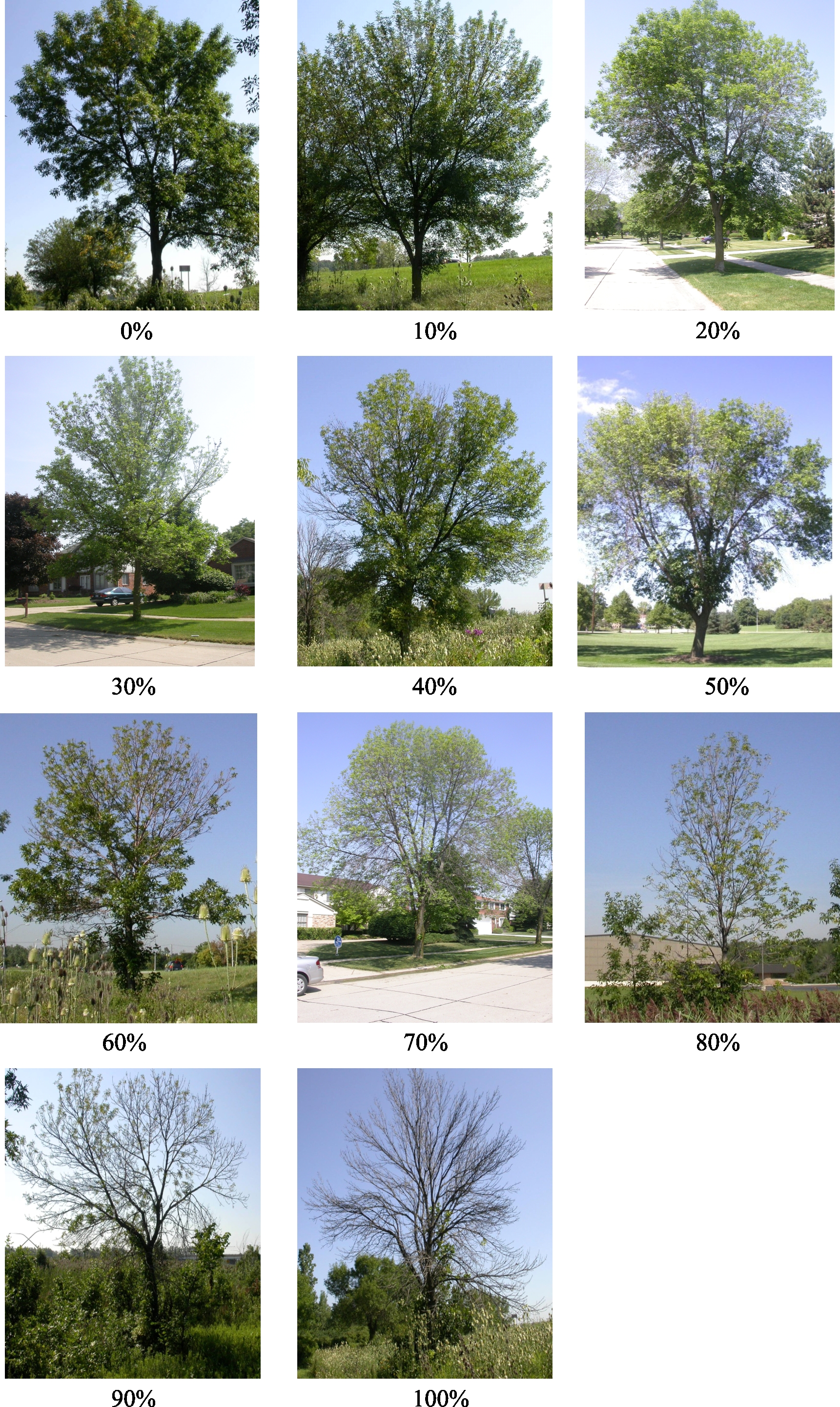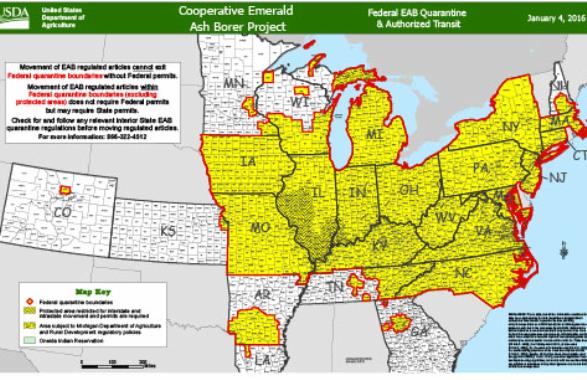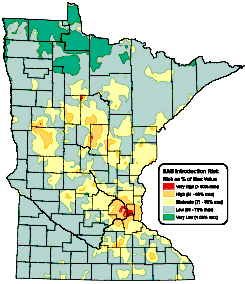First, you will see the different shots of the emerald ash borer. One is on top, one on bottom, and of course these little pest can fly too so they have a pic of one with its wings out. It is hard to tell the size of these little guys so I gave you a nice picture here on the bottom to relate the bug to something you will probably have in your pocket or purse at all times.that does this so I would suggest that you refer to it at the following link You will see a nice map of the Midwest region and the areas that are effected by emerald ash borer. Next your will see a group of ash leaves. And finally you will see the buds. I like the link on this page quite a bit better so check that out. I would tell you to never jump to conclusions because you see some of the signs thinking you have emerald ash borer. So as you will see on the left there are three pictures. The first one is of an ash tree that has shoots growing heavily out of the base of the tree and out of branches. Notice the leaves stop at certain points. Those are the points where you should be able to spot emerald ash borer damage like the next two pictures. The picture with the finger is showing off the shape of the holes they leave. This shape is unique to emerald ash borers. It is also the same shape as bronze birch borers but bronze birch borers only effect paper birch. Next picture is of the larvae patterns in the living area of the tree. All of the bottom pictures are good indicators that you have insect damage in a tree in general. Not just emerald ash borer but any borer in any tree. See right next to it the bronze birch borer. They look just like the emerald ash borer but just a different color.Most people hear about insects and just think that every green bug is an emerald ash borer because they have heard about it so much and have seen so many reports. The bug on the bottom side of the emerald ash borer is a weevil and are often found in vegetation. Many of the other insects look like emerald ash borer. Some do not and are really common. Notice some of the characteristics of the emerald ash borer. It has a straight line down its back as its wings do not tuck. It is not segmented like may other beetles and insects. It also has a very sleek body and is 1/2" long at adult size. This picture on the left is a great tool when you are looking at the effects of emerald ash borer. The only thing they do not do a good job of is showing the same tree digress over time. It would take approximately three years to go from a 100% healthy tree to a 0% or completely dead tree.
The progression of this disease also depends on the rate of infection but it is said that three year lifespan is average. In the diagram they show how infected the tree is. As you will notice it is hard to tell your tree is infected until about the second year. By this time survival rates with chemicals drop from 95% to around 50%. In the initial stages of this disease it will be more of a judgement by the customer if there tree has less leaves then it did in the spring. It is pretty easy to tell when a tree is too far gone. In my professional experience people are very good at noticing when there trees are either dead or nearly dead. It is generally too late at this time so it is hard to help a dead tree come back to life. We suggest that people be proactive and treat for Emerald Ash Borer before the disease comes to the area. Most chemicals will only be effective if used for three years before infestation. Problem is that insects are dispersed everyday for a number of reasons. Dandelions were brought here to make salad and now you find them everywhere. This bug could have been brought in either on purpose or by mistake. It could be as simple as some bugs were stuck on the underside of a vehicle leaving the infected area. Unfortunate, we cannot stop what is going to happen. If you do not do anything to solve for the problem this insect will keep on killing trees. In Minnesota we have over 900 million ash trees. It is important to know which trees get Emerald Ash Borer.
Maybe the most crucial thing that people fail to do is identify that they have an ash tree. I have a whole page dedicated to ash tree identification: ASH TREE IDENTIFICATION. You can also follow on with the picture on the left.
Next important is the identification that your tree may have emerald ash borer. There are nearly ten different insects that feed on ash trees, and many of them show similar symptoms. If you see any of the signs, like that in the pictures on the left, you will want to have your tree inspected and most likely treated with insecticide. If you find D shaped holes, and you have an ash tree, you definitely have EAB.
Tip: EAB larvae are what does damage to the tree itself, and not the pretty little green metallic bug. The adult emerald ash borer lay eggs that turn into these larvae. The larvae eats the living layer of the tree and the tree dies. Find the arrow in the picture below? It points to the phloem of the tree or the living area.
Arbor Doctor has always went above and beyond when it comes to knowledge of the latest and greatest breaking news. This page is to help you learn more about this devastating insect reeking havoc on ash trees all over the Midwest, and ways to protect your ash trees.
On the left hand side of this page is one of the best images to show what Emerald Ash Borer looks like, and how to tell if it has started to attack your ash tree.
There are many different insects and they can look very similar. The diagram below is from the DNR out of Minnesota. Here you will find many different insects that look just like the emerald ash borer. I have had many customers think they saw EAB when all they have is the harmless weevil pictured below the circled EAB.
Notice on this line up you will find the Japanese beetle. They do not effect ash trees but they do kill off linden trees. You can learn a lot more about this bug here: JAPANESE BEETLES.
Tip: Be proactive when dealing with insects such as EAB. It has been reported in Michigan studies that trees that were in the 10% stage were brought back to life with many different treatments. It is harder to try to save a tree already dying from EAB damage than a healthy tree not yet affected.
An updated quarantine zone for emerald ash borer in 2016 will include the following counties:
- Anoka
- Chisago
- Dakota
- Fillmore
- Hennepin
- Houston
- Olmstead
- Ramsey
- Scott
- Washington
- Winona
Homeowners in the above counties are advised not to move firewood out of the quarantined counties to help slow the spread. Homeowners can look to treat or remove ash trees to help with the emerald ash borer problem. Being under quarantine may not mean you are an ideal candidate for treatment.
Check out the following link to find out how close you are to the latest known infestations.
You will notice on the left a map of the Midwest region of the United States. Here are some very important details that you should know about emerald ash borer:
- Minnesota has the second most amount of trees that can be infected by EAB only to Ohio
- Michigan was the first state infected
- Infestation first found in 2002
- Insects were brought over on crates from Japan
- Has killed approximately 50 million trees so far
- 7.5 billions ash trees are in the United States
- Minnesota is the newest state infected with emerald ash borer
As you will notice, this problem has not affected Minnesota like it has many other states. The red dots in this map are areas that emerald ash borer has been detected. This does not mean that our map has to look like Michigan or Ohio, but mass infestation is in our future without action.
Image Provided By:
Smitley, David, Terrance Davis and Eric Rebek. 2008
Progression of ash canopy thinning and dieback outward from the initial infestation of emerald ash borer (Coleoptera: Buprestidae) in Southeast Michigan.
J. Econ. Entomol. 101: 1643-1650
Emerald Ash Borer
The picture below shows trees declining from EAB or other insect damage. You can check out all of your trees for these kinds of symptoms. It can take an average of three years.
Wood peckers feed off of bugs, and they peck into trees trying to find food to eat. Larve are really good food sources for woodpeckers, so take note when they show up on any tree.
Vertical splits in your tree can be an indicator of insect damage. Usually, you will be able to see the larve in these cases. This is a little more rare and is not always a sign of insect damage. Sometimes it is just a tree growing too fast for it's bark.
Treatment
Emerald ash borer has many different treatment options. Trunk injections near the base of the tree have been proven the most effective in field studies. Emmamectin Benzoate has been the industry leader in treatment of emerald ash borer. Other methods including bark banding and base drenching have shown some success in tests. Chemical treatment should be done on healthy trees to prevent infestation rather than waiting until the tree is damaged.
